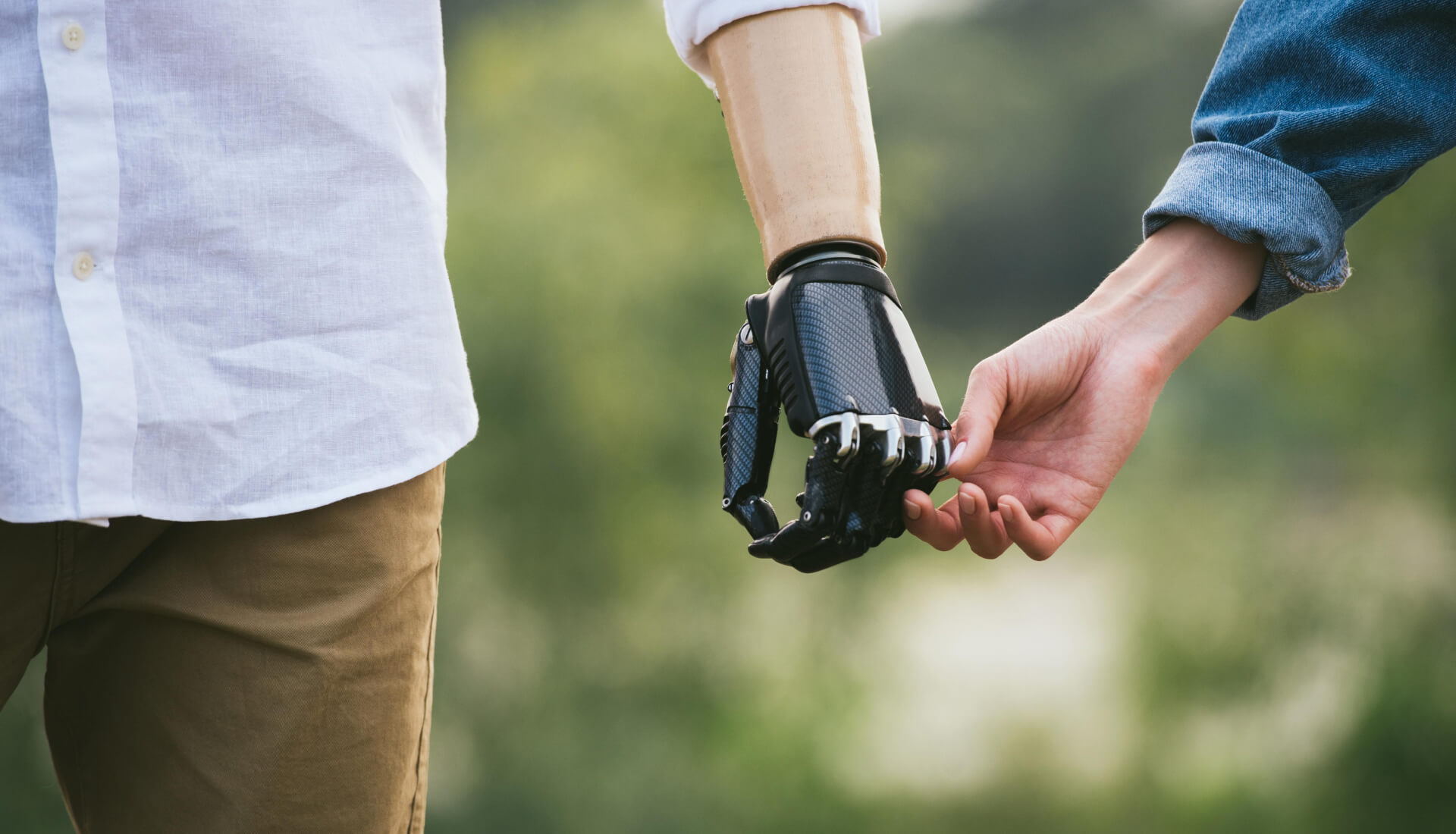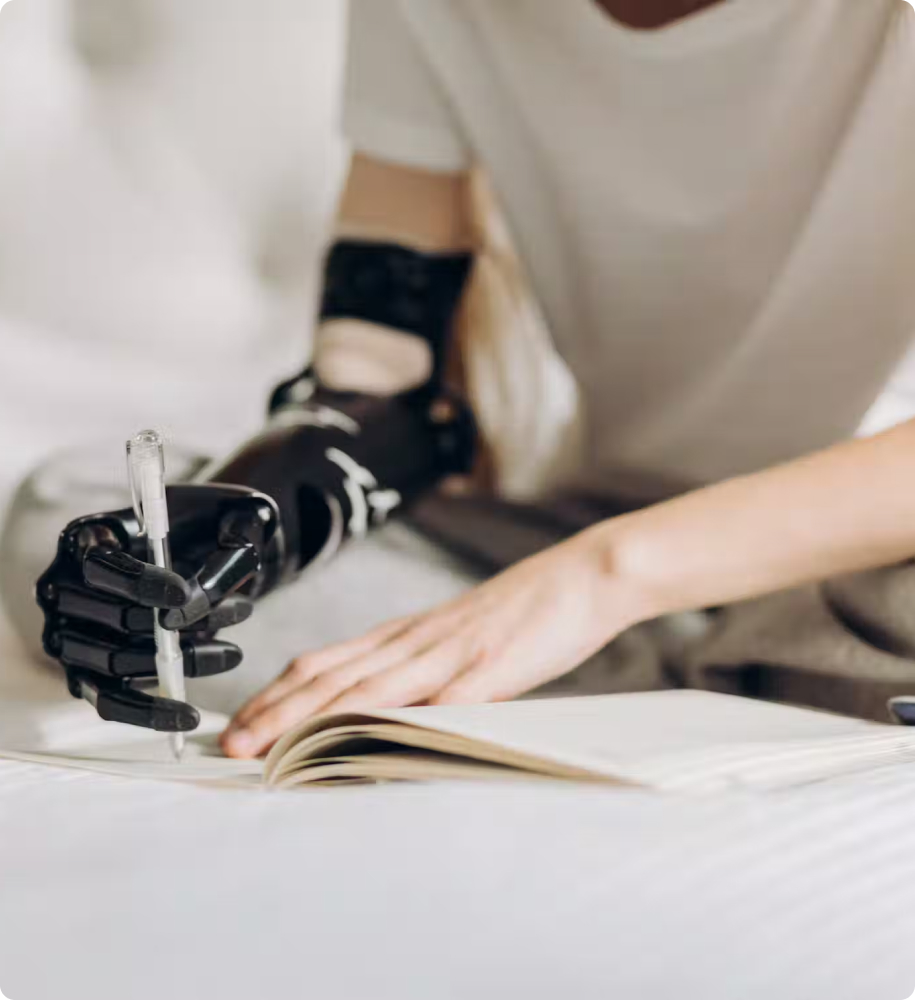In case of amputation at the level starting with the amputation of one phalanx of one finger and ending with the amputation of all fingers and almost the entire hand, prosthetic hands are recommended.
Depending on the level of amputation, prosthetics options are considered individually. Prosthetic brushes can be: cosmetic, active, working, with microprocessor control.
Upper limb prostheses
ORTO-M produces upper limb prostheses taking into account all the characteristics of each patient

Basic information
Upper limb prostheses are divided by amputation levels

Types of upper limb prostheses
In case of amputation of the upper limb at the level below the elbow joint, a prosthetic forearm is recommended. Forearm prostheses can be: cosmetic, active, working, with microprocessor control.
In case of amputation of the upper limb at a level below the shoulder joint, a shoulder prosthesis is recommended. Shoulder prosthesis can be: cosmetic, active, working, with microprocessor control. Depending on the length of the stump, some types of prostheses may be impractical to manufacture.
In case of amputation of the upper limb at the level above the shoulder joint, as well as in case of interscapular-thoracic amputation, prostheses for separation in the shoulder joint are recommended. Prostheses for this type of amputation can be: cosmetic, and with microprocessor control. With unilateral amputation, patients, as a rule, use exclusively cosmetic.
Active (traction) prostheses
Prostheses of any amputation level with traction control system are quite functional, but their functionality is limited by the amputation level. The higher the amputation, the less functional the prosthesis will be.
Active prostheses consist of a stump sleeve with an attachment system, a carrier sleeve with a control system, a wrist joint (elbow joint during amputation above the elbow) and an active hand (non-removable) as a terminal device.
Working (traction) prostheses
These prostheses are quite functional, but their functionality is limited by the level of amputation. The higher the amputation, the less functional the prosthesis will be.
Working prosthetics of the forearm consist of a stump-receiving sleeve with a fastening system, a carrier sleeve (elbow joint during amputation above the elbow) and a receiver of working attachments as a terminal device. A variety of working nozzles, both specialized and universal, are inserted into the receiver of the working nozzles, maximum functionality can be realized due to the hook.
Prostheses with microprocessor control
MIO(bio) electric forearm prostheses (with an external energy source) are the most modern technologies in upper limb prosthetics.
The prosthesis is controlled by the sensors reading pulses on the surface of the stump. Mio(bio) electric prostheses of the forearm (with an external energy source) consist of a stump sleeve with a fastening system and with mio (bio) contacts, a carrier sleeve with a base for the power supply and with a switching system, a wrist joint (elbow joint during amputation above the elbow, which can also be with the mio/bio system controls) and brushes with electric drive with control systems built into them
Cosmetic prosthetics
Cosmetic prosthesis of any amputation level performs an aesthetic function. Cosmetic prostheses are as close as possible to the natural appearance of the lost limb, but at the same time have the most minimal functionality.
Cosmetic prostheses consist of a stump sleeve with an attachment system, a carrier sleeve, a wrist joint (elbow joint during amputation above the elbow) and a cosmetic brush as a terminal device.

Microprocessor-controlled prosthesis

Cosmetic prosthesis

Prosthetic hands

Forearm prostheses
Fastening of upper limb prostheses
This option is possible for forearm prostheses. This type of attachment is recommended mainly for small and medium-length stumps.
Advantages of fastening:
- The absence of any straps and straps. There is no need to take off outerwear when putting on and removing the forearm prosthesis.
- High lateral (lateral and medial) walls of the cultured sleeve and, accordingly, greater stability of short stumps.
- The absence of any components for the manufacture of this type of attachment.
Disadvantages:
- Absence of pronation-supination movements, which is usually relevant for long stumps.
- Some difficulty putting on the prosthesis.
- The high complexity of manufacturing a competent form of gripping the attachment area, especially in the area above the medial condyle, and as a result, frequent alterations of the sleeve.
This option is possible for forearm prostheses.
Advantages:
- Relative ease of putting on the prosthesis. There is no need to take off your outer clothing.
- The presence of pronation-supination movements, which is usually relevant for long stumps.
- Low price.
Disadvantages:
- The presence of leather straps and straps and related problems with scuffing of the stump skin and its increased sweating, the inability to periodically wash leather parts and, as a result, an unpleasant smell.
- Additional technological operations in the manufacture of a forearm prosthesis.
- This type of attachment is recommended mainly for stumps larger than the average length.
This option is possible for forearm and shoulder prostheses. This type of attachment is recommended mainly for stumps larger than the average length.
Advantages of fastening:
- Relative ease of putting on the prosthesis.
- The presence of pronation-supination movements, which is usually relevant for long stumps.
- Unloading of the supracondylar zone of the humerus and the possibility of lifting large weights with a prosthesis (approx. 20-30 kg!)
- The possibility of disassembling and washing most parts of this fastening system.
Disadvantages:
- The presence of a leather triceps cuff, a loop under the arm of a preserved arm and synthetic straps, and related problems.
- Additional technological operations in the manufacture of a forearm prosthesis.
- The need to remove /put on outerwear when removing / putting on a prosthetic forearm
This option is possible for forearm and shoulder prostheses.This type of attachment is recommended mainly for stumps larger than the average length.
Advantages of fastening:
- Relative ease of putting on the prosthesis.
- The presence of pronation-supination movements, which is usually relevant for long stumps.
- Unloading of the supracondylar zone of the humerus
- The possibility of daily washing of the silicone cover (liner).
- Minimal backlash (piston movements) of the forearm stump in the stump sleeve of the prosthesis.
Disadvantages:
- Problems associated with adaptation to a silicone cover: increased sweating during the adaptation period, possible allergic reactions to an unfamiliar type of attachment.
- Additional technological operations in the manufacture of a forearm prosthesis.
- High cost
- Inability to lift heavy weights with a prosthesis (max. up to 3-5 kg!)
- Sharp restriction of mobility in the elbow joint for short stumps.
The combined fastening system is a combination of two types of fastening - type 3 and type 4.
This option is possible for forearm and shoulder prostheses.
Preparation of the stump for prosthetics
Immediately after amputation, it is impossible to be prosthetic, but in each case there should be its own time and its own type of prosthesis.
The first thing after discharge from the hospital and removal of stitches is the healing process.
Secondly, with the permission of the surgeon who is observing the patient, it is necessary to prepare the stump for prosthetics – to be bandaged with an elastic bandage. The term of bandaging is about 2-3 weeks, according to the schedule.
The next stage of preparation for prosthetics is "acquaintance" with a silicone case. Patients who come to us for prosthetics receive a case, and stay in it from 3 weeks to 2 months. Firstly, it is necessary to detect a reaction to silicone, and secondly, to change (decrease) the volume of the stump.
If you make a prosthesis on an unprepared stump, then for some time using the prosthesis, the stump will lose weight and it will be difficult to use the prosthesis.
Bandaging the stump
Before prosthetics, compression therapy with an elastic bandage is recommended.
Day number
Bandaging time
Break time
Day 1
20 min
20 min
40 min
20 min
60 min
20 min
Day 2
40 min
20 min
60 min
20 min
80 min
20 min
Day N
+20 min
20 min
The time of bandaging during the day: +20 minutes to the previous time.
Start a new day: +20 minutes from the start time of the previous day.
Sign up for a consultation